Reclaimed Fabric Jester Doll
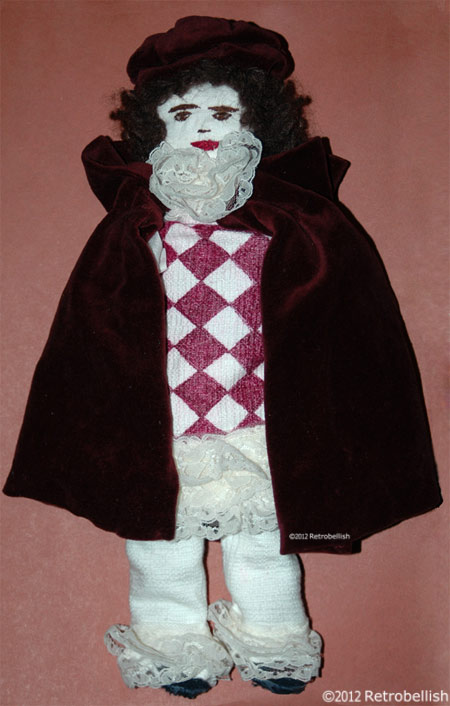
This little jester started out as an idea I had to make a medieval style doll about five years ago. I have always been inspired by the medieval style clothing from some of the great classic movies. The colors, the style and flow of the fabrics have always been a fascination of mine. A few weeks ago, while looking through my fabric remnants, I saw beautiful colors and lush textures that inspired me to make a jester doll.
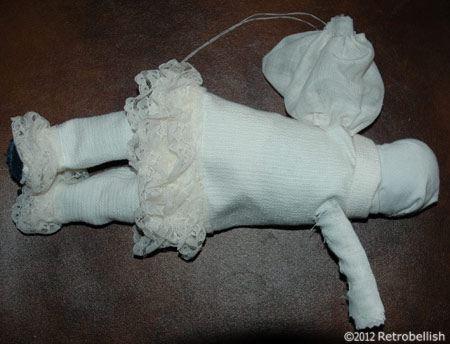
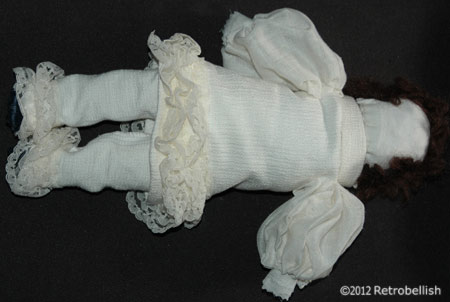
Completed Jester Body
First, I had to create the doll’s body and since this would be an abstract cloth doll, I decided to use the fabric from an old cotton sweatshirt. I cut a lengthy portion from one sweatshirt sleeve and rolled up the cut piece forming a firm makeshift torso and sewed the edges to the rolled up portion. Next I cut smaller pieces from the same sweatshirt, rolled up the piece to make an arm in the same fashion as the torso and repeated these steps to make the other arm. I then sewed each arm piece to each side near the top of the torso. I followed the same procedures to make the legs and sewed them to the bottom portion of the torso.
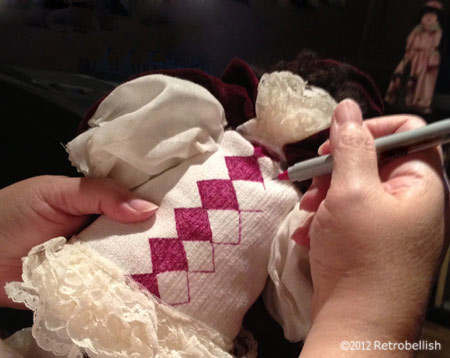
The head was challenging, but I used the same sweatshirt remnant from which I cut one lengthy piece. I rolled one long piece into a rounded ball shape and when big enough in proportion to the body, I pinned it in several spots and started sewing along all edges to secure the ball shape as much as possible. I cut apart old sheer knee high stockings and placed a piece over the round head shape, stuffed more cotton pieces at the base to make a neck and started sewing that part to the body. Next I looked through my remnant box and found a small piece of soft white cotton that was large enough to sew over the entire head. I took brown colored sewing thread to sew the jester’s eyes, eyebrows and nose. I used red sewing thread to make the lips. I then used brown curly wool trim to make the hair by sewing down the strips to the head.
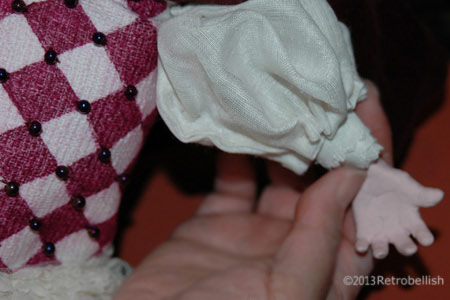
In my remnant fabric box, I found a beautiful cream colored cotton fabric, which was large enough to make the jester’s tunic, sleeves and pants. I spread the fabric out on a table and laid the doll flat over the folded fabric. By eye, I used a pencil to lightly trace around the doll creating a pattern on the fabric and (leaving a generous 1/2 inch seam allowance). I cut out the drawn pattern to sew the doll’s clothes. When I finally finished the jester’s clothes, I used a maroon colored permanent fabric marker to draw and color in a harlequin pattern onto the tunic. I had a roll of cream colored lace trim that perfectly matched the cream colored clothes. I used cream colored sheer cotton to separately make sleeves and connected them to the tunic at the shoulders and around the armholes.
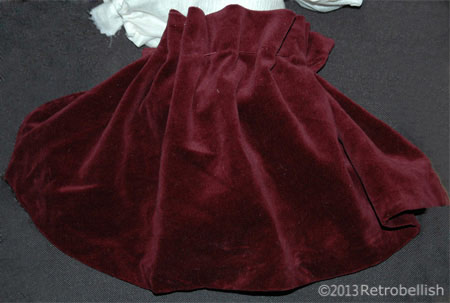
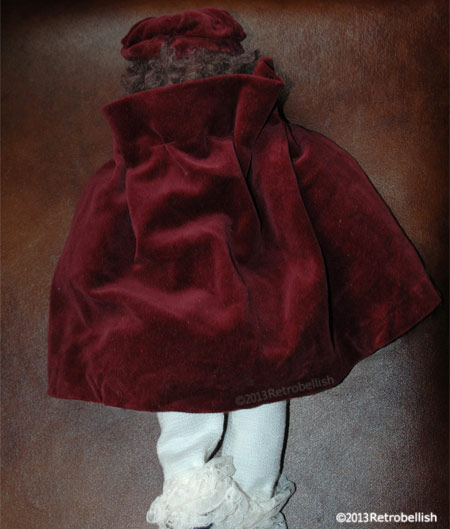
I also found a beautiful maroon colored velour fabric piece in my remnant box (cut from an old jacket of mine) and saw that it was perfect in size to make a cape for the doll. Using a matching maroon colored thread and needle, I basted long stitches about one inch from the cape’s top edge hemline. I sewed smaller single stitches down each side of the cape, placed it over the doll’s shoulders, and sewed a bottom hemline on the cape. Next, I decided to make a hat for the jester, so I took another maroon velour remnant and cut it into a trapezoid shape. I sewed together the longest edges forming a tubular shape (leaving the top and bottom ends open), and sewed the smaller opened side to the jester’s head (through the white fabric and hair), flattened down the rest of the tube while puffing out the fabric, which piled nicely forming a round puffy shape, sewed tiny stitches to hold the folds in place, and continued to form the hat as I went along. Then I sewed the center of the hat down through the center and hid those stitches under one of the folds of the last layer. I was very pleased with the results.
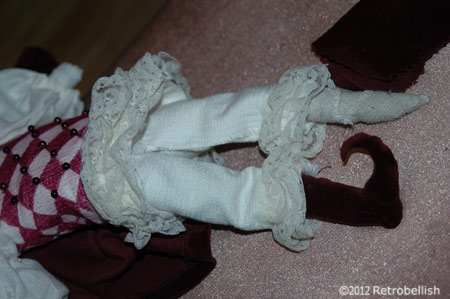
I adorned the harlequin pattern on the jester’s tunic by sewing on some maroon colored beads. I also made the jester’s boots from the same maroon velour fabric and sewed tight stitches to create the curled points on the boots.
Just like in some of the old movies I’d seen, I wanted the jester to be holding a mandolin. I looked up a picture of a mandolin on-line, drew it onto a piece of regular paper and figured out an appropriate size mandolin by holding it up against the jester. Once I figured out the correct size in proportion to the jester, I traced the mandolin pattern onto heavier paper and again onto corrugated cardboard. Next I measured where to make the center hole on the mandolin and used a paper punch to do so. Using acrylic craft paints, I painted the mandolin details onto the heavy paper pattern and let it dry.
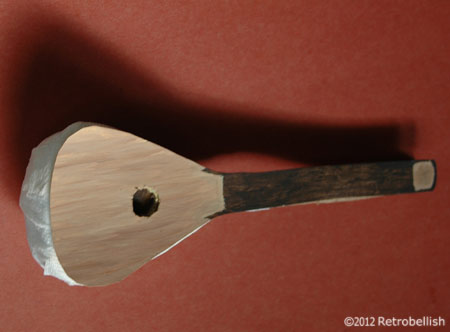
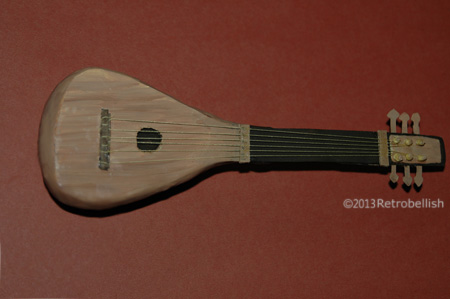
Next, I worked with the heavy corrugated cardboard mandolin and neck cutouts and glued them together. The lower back portion of the mandolin body was rounded (as if made from a hollowed out gourd). I achieved that look with paper mache (which I made from scrap paper towel strips watered down with white glue) and affixed that small round shape to the mandolin’s back by wrapping long narrow mache strips from the back and around to the front of the mandolin’s body. I then placed the mandolin on a piece of waxed paper and near the heating vent to dry. Once it dried overnight, I was able to remove the mandolin from the waxed paper without any problem. Next, I glued the painted mandolin paper veneer over the face of the heaver paper mache mandolin piece and painted the rest of the mandolin to match the already painted top veneer.
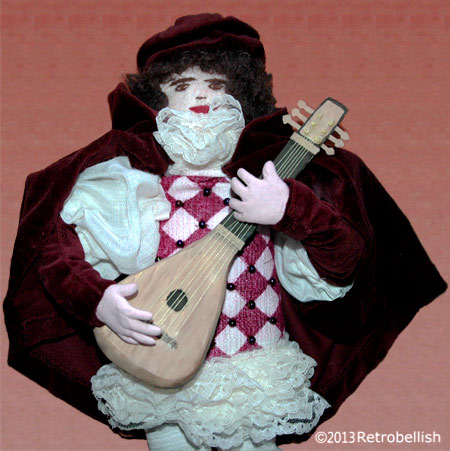
I cut small rectangular corrugated cardboard pieces to make the bridge and nut pieces on the mandolin, then used bright yellow sewing thread and fabric glue to adhere the strings onto the tiny rectangular bridge. Once the strings dried in place, I cut (with sharp scissors) the ends off of rounded toothpicks to make the tuning heads and pushed those cut pointy ends (dipped into a little glue) and into the head. Once they dried in place, I took one string at a time, dabbed glue around the tiny tuning heads and with tweezers, began wrapping each thread around its corresponding tuning head and cut off the excess. Once everything was dried, I placed the nut in place, and used glue to line up the strings evenly in place.
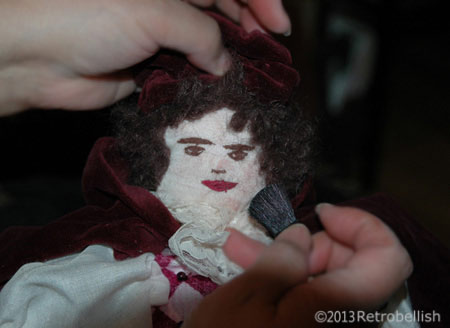
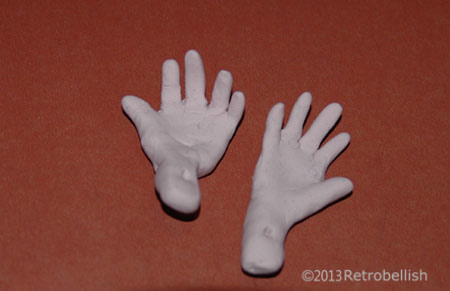
Last, but not least, I made the jester’s hands from flesh colored polymer clay. I rolled each finger and made some slightly longer or shorter matching the sizes for each hand. I made the palm part, a longer wrist part, pierced the end of the arm part with a toothpick (so that I could later sew the arm to the sweatshirt arm). I then attached the fingers onto the hand part and held them in front of me and while mimicking playing a guitar, curved the hands and shaped the fingers. I carefully placed the complete shaped pieces onto aluminum foil and baked them in the oven (carefully following the clay manufacturer’s instructions).
Although this project took me over a month to complete in my spare time, it can be done in several days with the right amount of time. And although I chose to make a jester doll, you could give it a try with any doll you’d like. So just have fun and create your own reclaimed fabric doll.